Adding flowering bushes to your Florida garden can save you so much time and keep you out of the heat. They offer gardeners year after year of color and texture with no yearly bed prep or planting out. They’re landscaping workhorses that deliver years of satisfaction. The best flowering bushes for Florida can create structure and tone and set the whole mood for your garden with a lot less hard work in the heat and humidity.
So, which are the best flowering bushes for Florida? Some good doers for our hot and humid climate include hardy and tropical hibiscus. Other great flowering perennials for Florida are Arabian jasmine, camellias, azaleas, plumbago, tibouchina, duranta, firebush, bougainvillea, and gardenias.
Which Are the Best Flowering Bushes for Florida?
Add drama and structure by using flowering bushes in your Southern garden. Most offer year-round color and evergreen foliage while attracting wildlife to your yard.
Best of all, you’ll only need to plant them once. After they’re established, you can rely on them for years to come with only the occasional feeding and pruning.
Here are 12 of our very favorites:
1. Arabian Jasmine (Jasminum sambac)
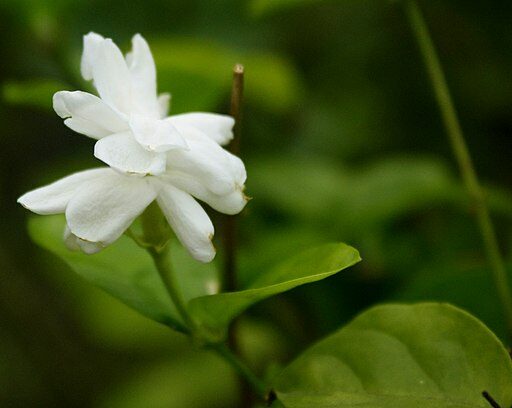
Arabian jasmine (Jasminum sambac) delivers delicate and delicious-smelling white flowers. They’re also evergreen, so your garden will never look bare and scrubby in the colder months.
Even better, they’re fine with a little shade, though you may not get as many blooms. They can spread with a few viney offshoots (perfect for cuttings), but you can also keep them pruned for container gardening.
On the whole, they’re a large, showy bush that requires very little maintenance.
Jasminum sambac belongs to the Oleaceae family and is commonly referred to as Sambac Jasmine, Jasmine Sambac, or simply Arabian Jasmine. It is widely cultivated for its intoxicating scent and ornamental value.
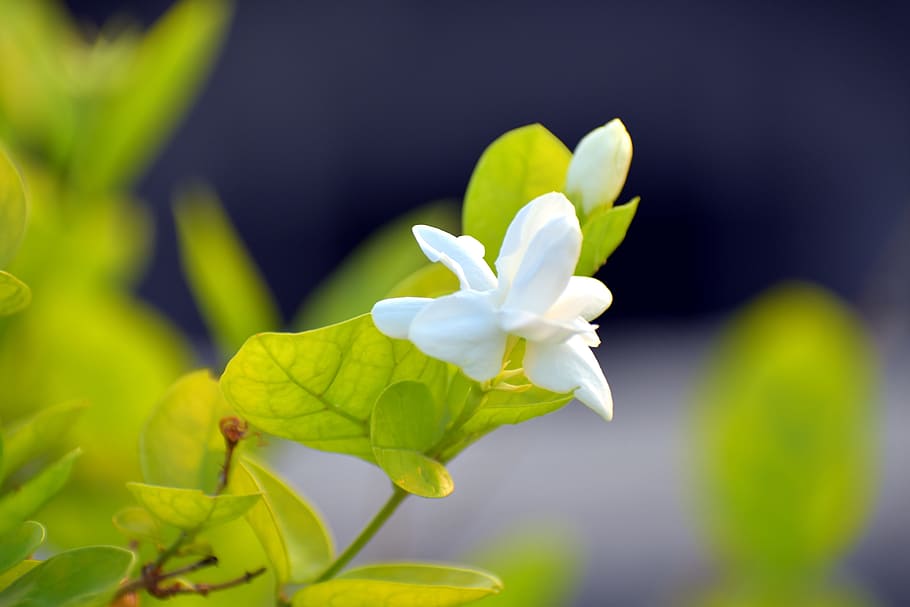
Arabian Jasmine Description
Arabian Jasmine has glossy, dark green leaves with an oval to lanceolate shape. The leaves grow in opposite pairs along the stems and provide an attractive backdrop to its white flowers.
The hallmark of Arabian Jasmine is its exquisite and highly fragrant flowers. The blooms are small and star-shaped, with five or more petals, and they are pure white in color. The intoxicating scent of the flowers fills the air, especially during the evening.
Arabian Jasmine is a vining shrub with a semi-climbing growth habit. It can reach a mature height of 6 to 10 feet or more, depending on the support structure it grows on. It is often trained to climb trellises, fences, or walls, but it can also be pruned into a more compact form.
Arabian Jasmine Optimal Growing Conditions
Arabian Jasmine is believed to have originated in South Asia, specifically in India or the southeastern parts of Asia.
It thrives in warm and humid climates, making it well-suited for Florida’s tropical and subtropical conditions.
For optimal growth and flowering, Arabian Jasmine prefers full sun to partial shade. The plant prefers well-draining soil with good fertility and benefits from regular watering, especially during dry spells.
Arabian Jasmine flourishes in Florida’s hardiness zones 9 to 11. It is not frost-tolerant and requires protection during cold spells or freezing temperatures.
Arabian Jasmine produces its fragrant white flowers throughout the year in warm climates, with peak flowering usually occurring in spring and summer. The sweet scent of the flowers attracts bees, butterflies, and other pollinators, contributing to the garden’s biodiversity.
2. Azalea (Rhododendron indicum)
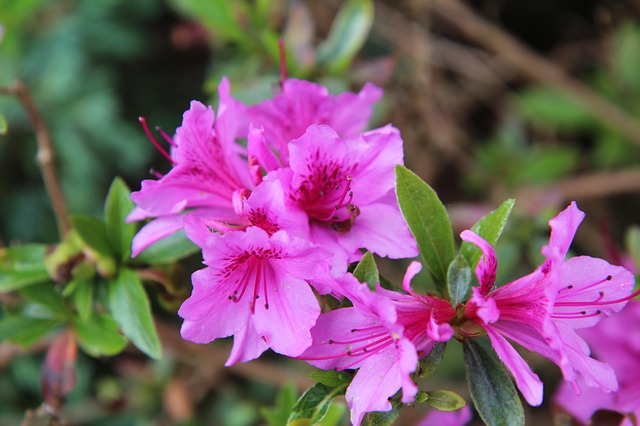
When you think of gardening in the South, you think of azaleas. These big blousy bushes set blooms in such an explosion of color that you can’t help but be tempted. And the range of colors is just as exciting, with whites, creams, pinks, reds, purples, and even oranges. Their evergreen foliage provides year-round structure
Most gardeners think it’s a must if you’re growing in warmer zones. However, if you’re gardening in Zones 10 and 11, you may need to pass.
Evergreen azaleas, also known as Rhododendron indicum, are often grown for their colorful and abundant blooms. These plants belong to the Ericaceae family and are commonly referred to as Azaleas.
Azalea Description
Azaleas feature small to medium-sized leaves with an elliptical or ovate shape. The leaves are often evergreen, but some deciduous varieties shed their leaves in the fall. The foliage can be glossy or matte, and its color ranges from dark green to bronze or even variegated patterns.
The highlight of azaleas is undoubtedly their profusion of showy flowers. You’ll find azaleas in a wide range of colors, including shades of white, pink, red, purple, and even bi-color combinations. The flowers are usually funnel-shaped or tubular.
Some Azaleas are compact and low-growing, while others can become large, upright shrubs. The mature size of Azaleas varies widely, with heights ranging from 1 to 10 feet and spreads of 1.5 to 10 feet.

Optimal Growing Conditions for Azaleas
Azaleas are native to Japan, and they thrive in the cool, moist forests and mountains of their native habitat.
Azaleas prefer partial shade to filtered sunlight. They thrive in well-draining, acidic soil with high organic matter.
Azaleas are well-suited for Florida’s climate and are typically grown in hardiness zones 8 to 10. They can tolerate mild winter temperatures but may need protection from freezing temperatures in some regions.
Generally, Azaleas bloom in spring, and the vibrant flowers attract bees, butterflies, and other pollinators, contributing to the garden’s ecological diversity.
3. Blue Porterweed
This shade-tolerant flowering bush is a favorite of bees and butterflies and gives your garden a tousled, cottage feel. In 9B and below, it winters over well without any protection at all. It may even do well in Zones above if planted in a protected spot.
This is another one of those special plants that tolerate – and bloom well – in dappled shade. And best of all, it doesn’t sprawl out of control. While you can prune it, Nettle-leaf Porterweed rarely grows more than 4 feet high and 3 feet white. You may want to prune it back hard in the spring to encourage denser growth.
Blue Porterweed isn’t terribly thirsty, but it does require water once a week. And it may need more during hot dry spells and will let you know when it needs a drink in the summer.
4. Camellias (Camellia japonica)
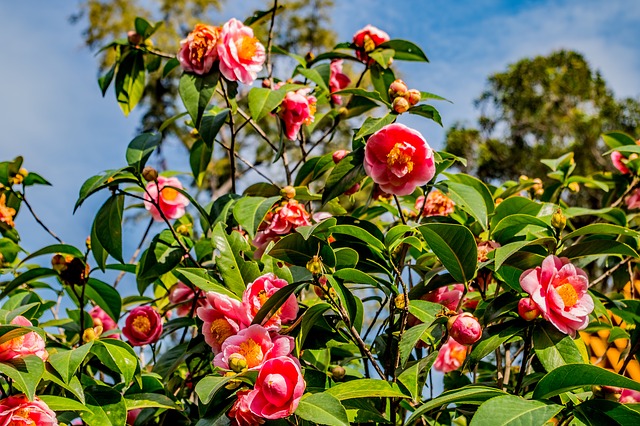
Camellias are considered a go-to for best flowering bushes for Florida. They’ve been a favorite since they were imported from China over 200 years ago. That may be because they bloom in the fall and winter, when most other flowering bushes have settled down for the year.
Their evergreen foliage provides privacy screens, and they do well in shady areas. Finding good flowering plants for shade is a real task in the South, but camellias have your back on this one. They bloom better in dappled shady spots than in sunny areas.
Plant camellias in acidic soil and give them three years to get established. Fertilizer with plant food for acid-loving flowering shrubs right after they’re done blooming.
Make sure you choose the best type for your zone. Japonica thrives in warmer regions, while sasanqua flourishes further north, which makes it one of the better flowering bushes for Zone 8.
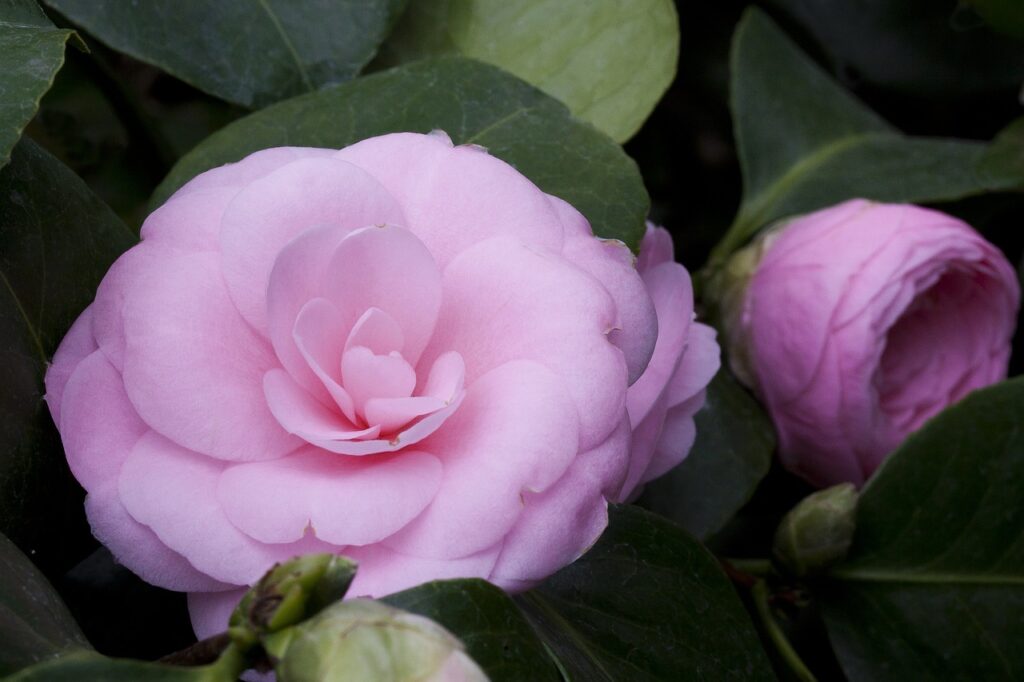
Camellia japonica Description
Camellias have lustrous, dark green leaves with a glossy texture. But the hallmark of Camellias is their exquisitely formed flowers. The blooms come in various colors, including shades of white, pink, red, and even bi-color combinations. The flowers are often large, measuring 2 to 5 inches in diameter, with a waxy texture.
Camellia japonica has a dense, compact growth habit with a rounded or pyramidal shape. The plant can reach a mature height of 6 to 12 feet and a spread of 6 to 10 feet, depending on the specific variety and growing conditions, although dwarf cultivars are also available.
Camellias Optimal Growing Conditions
Camellia japonica is native to Japan, and they in the cool, moist forests and mountains of its native habitat. For optimal growth and flowering, Camellias prefer partial shade to filtered sunlight. They prefer well-draining, acidic soil that is rich in organic matter.
Camellia japonica is well-suited for Florida’s climate and is typically grown in hardiness zones 7 to 9. It can tolerate mild winter temperatures but may need protection from freezing temperatures.
Camellia japonica typically blooms from late fall to early spring, providing a much-needed burst of color during the cooler months. The flowers are a valuable source of nectar for early-season pollinators, including bees.
5. Firebush
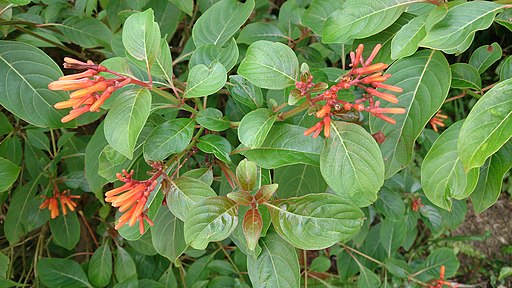
Firebush, or Hamelia patens, is a magnet for bees and butterflies and is perfect for Zones 8 to 11. This semi-woody perennial produces bright red and orange flowers, although colors differ between cultivars. That includes its foliage, which can range from deep green to yellow.
This beauty loves sun, though it can manage a little shade. Best of all, it’s pretty salt-tolerant, so it’s a good doer in coastal gardens like mine.
This Florida native delivers blooms year-round and can get up to 10 feet tall. Or, you can keep it in a pot to keep it small or choose a dwarf variety.
Firebush Description
The highlight of the Firebush is undoubtedly its striking tubular flowers, which are a vibrant red-orange color. The flowers are small and arranged in dense clusters, creating a fiery display of color that is highly attractive to pollinators, especially hummingbirds and butterflies.
Firebush typically forms a multi-stemmed, semi-woody shrub with an upright growth habit. It can reach a mature height of 6 to 12 feet and a spread of 4 to 8 feet.
The plant’s moderate size and dense foliage make it an excellent choice for hedges and screens.
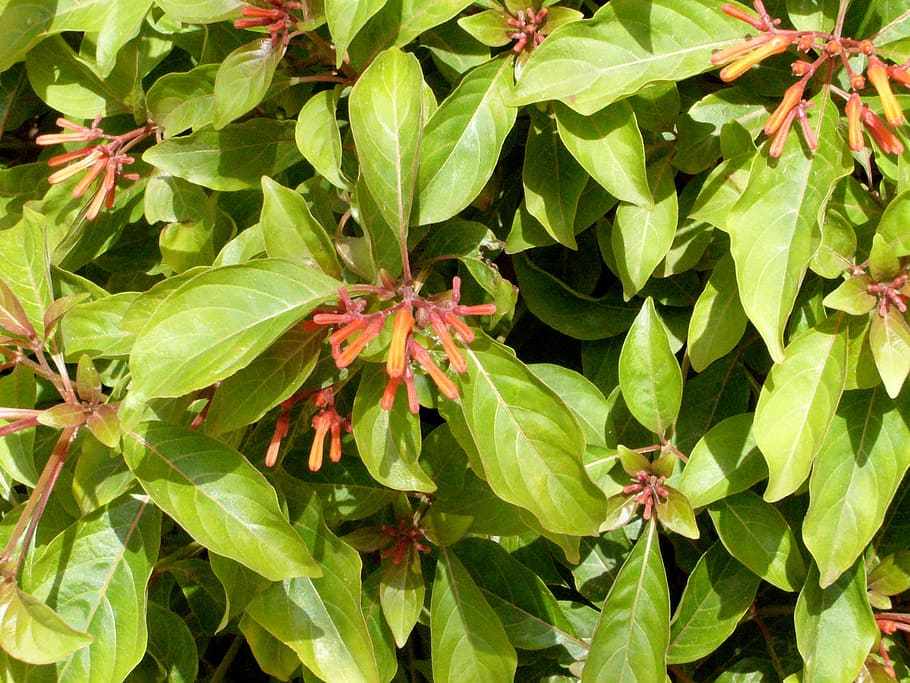
Optimal Growing Conditions for Firebush
Firebush is native to various regions in the Americas, including Florida, Mexico, and parts of Central and South America. It thrives in open woodlands, hammocks, and disturbed areas, demonstrating its adaptability to different habitats.
Firebush prefers full sun exposure and warm and humid conditions. The plant is reasonably tolerant of various soil types, but it prefers well-draining soil with moderate fertility. Once established, it displays good drought tolerance.
Firebush is well-suited for Florida’s climate and is typically grown in hardiness zones 9 to 11. It can withstand occasional light frost but generally thrives in frost-free regions, making it one of the better flowering bushes for Zone 9.
The tubular flowers are rich in nectar, making them highly attractive to pollinators, including hummingbirds, butterflies, and bees. Firebush is one of the flowering perennials for Florida that is a must-have for any butterfly garden.
Being native to various regions in the Americas, Firebush is well-adapted to Florida’s climate and soil conditions, making it a low-maintenance and sustainable choice for landscaping.
6. Gardenia (Gardenia jasminoides)
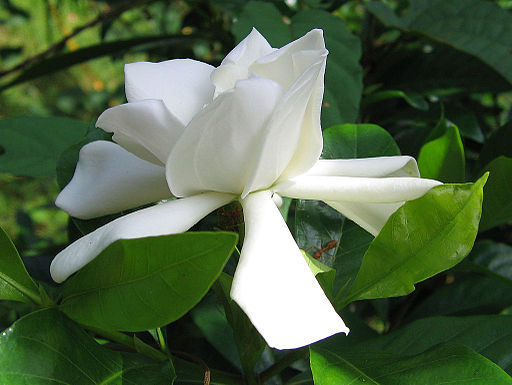
Some people think that the perfume of gardenias is just too cloying, but there’s nothing like catching that sweet aroma on the top of the breeze. They’re also prodigious bloomers, perfect for tropical and subtropical gardens.
They’re a bit fussy, so I grow mine in pots so I can move them during the year to partially shady spots in the summer. They also like a lot of water, and I find that easier to accomplish in a container.
The luxurious-looking flowers come in a range of white, from stark to cream to nearly yellow, depending on the cultivar. They prefer acidic soil but aren’t too fussy about its density as long as you ensure good drainage.
Gardenia Description
Gardenias have glossy, dark green leaves with an elliptical to ovate shape. And the deep green foliage forms an attractive backdrop for the pristine white flowers, creating a striking contrast.
Gardenia blossoms are typically pure white, with a waxy texture and a beautiful rose-like shape. Its classic beauty makes it one of the most popular flowering plants for Florida.
Gardenias are evergreen shrubs with a bushy growth habit. They can reach a mature height of 3 to 6 feet and a spread of 2 to 4 feet, though you’ll also find dwarf cultivars.
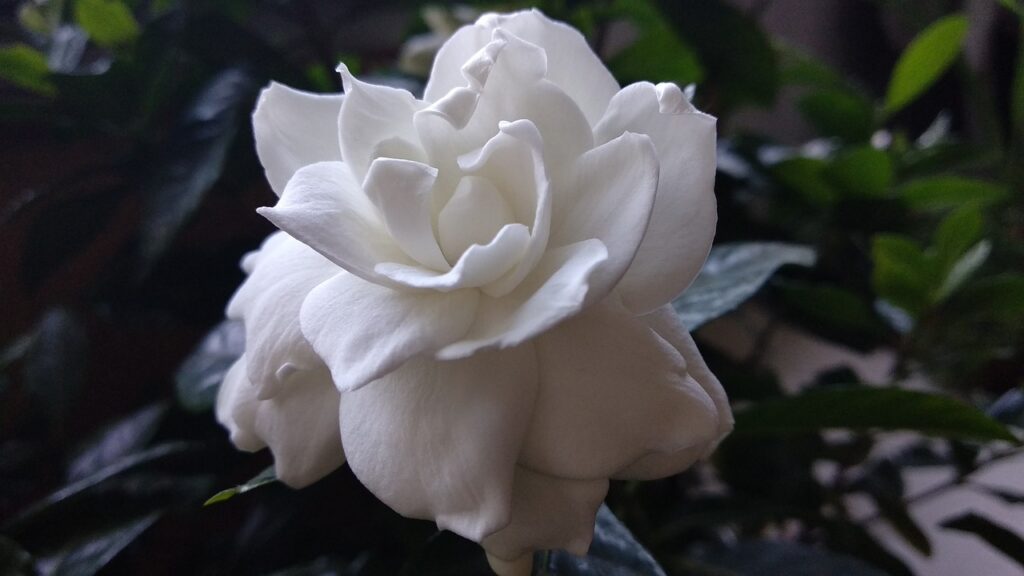
Optimal Growing Conditions for Gardenias
Gardenia jasminoides is native to China and other regions in Asia. In its native habitat, it grows in forests and woodlands, where it enjoys partial shade and a humid environment.
Gardenias prefer partial shade to filtered sunlight. They thrive in well-draining, acidic soil that is rich in organic matter.
Gardenias are well-suited for Florida’s climate and thrive in hardiness zones 8 to 11. They are well-adapted to the state’s warm temperatures and can withstand occasional light frost.
Gardenias typically bloom from late spring through summer, producing a profusion of fragrant white flowers.
Since Gardenias thrive in partial shade, they’re a boon to Florida gardeners with awkward shady spots in their landscape.
7. Golden Dew Drop (Duranta erecta)
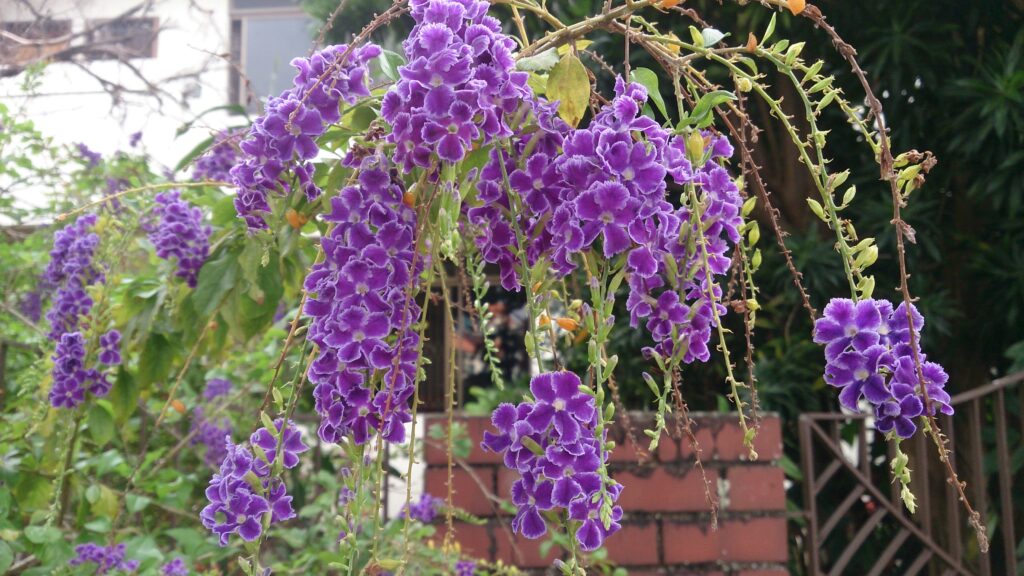
Duranta, or Golden Dew Drop (Duranta erecta), is another favorite of pollinators and it adds great flowering drama in any Southern Garden. The weeping branches become covered in tiny purple flowers, which then become bright golden berries – hence the name.
Best of all, it blooms all year round in Zones 9 to 11.
It can get shaggy and overwhelming, but if you’re competent with pruning shears, you can keep it from growing to its max height of 18 feet. I’ve trimmed mine to grow into trees, with hanging branches covered in flowers, because I’m just too impatient for wisteria.
Caveat: The berries on Golden Dew Drop are poisonous to humans, so make sure you keep children from eating them. Luckily, they don’t drop easily, so they’re easy to trim and dispose of regularly.
Golden Dew Drop Description
The Golden Dew Drop’s foliage consists of glossy, elliptic leaves that grow opposite each other along the stems. The foliage is evergreen, providing winter garden interest.
Duranta produces small, tubular flowers that form in pendulous clusters of purple, blue, or white. These flowers are highly attractive to pollinators like bees, butterflies, and hummingbirds. This is one of the most overlooked flowering perennials for Florida.
This flowering bush has a compact and bushy growth habit, typically reaching a mature height of 6 to 12 feet and a spread of 3 to 6 feet.
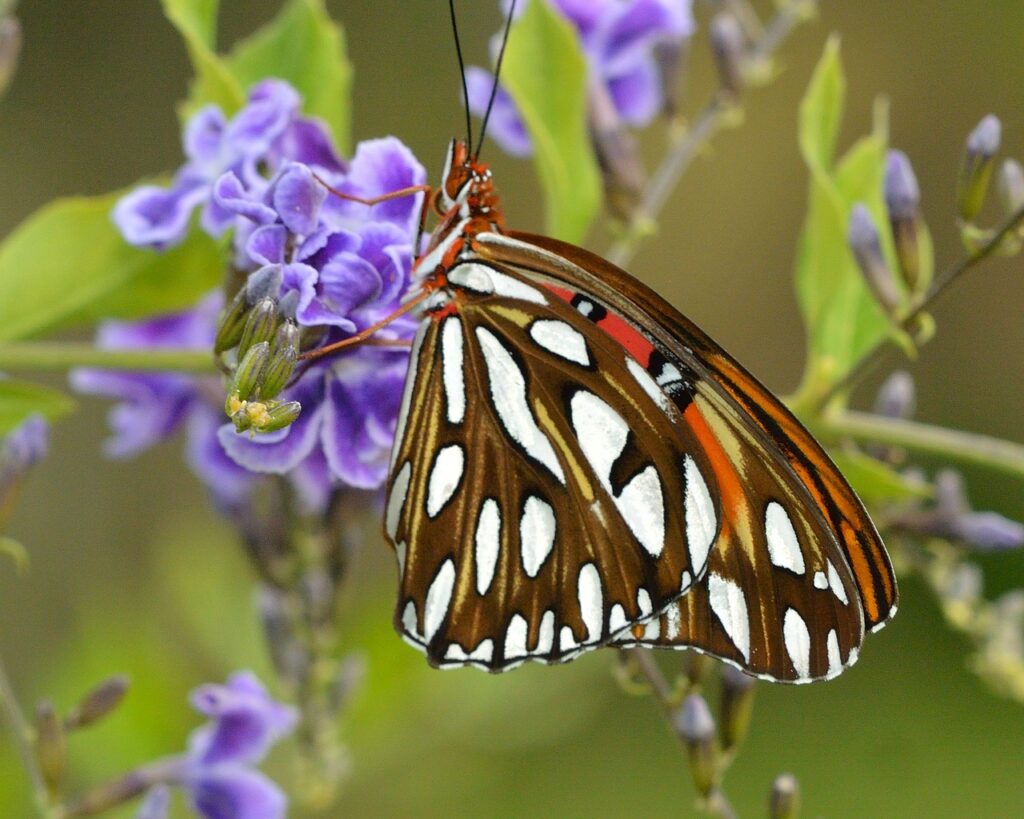
Optimal Growing Conditions for Golden Dew Drop
Golden Dew Drop is native to tropical regions of the Americas, including parts of Florida, Mexico, and the Caribbean. It thrives in warm and humid climates.
Golden Dew Drop prefers full sun exposure, receiving at least six hours of direct sunlight daily. It is reasonably adaptable to different soil types, but well-draining soil with a slightly acidic to neutral pH is ideal.
Once established, the plant exhibits good tolerance to drought conditions, making it suitable for Florida’s climate.
Duranta thrives in hardiness zones 9 to 11, which align perfectly with Florida’s tropical to subtropical climate. It can withstand occasional frosts, further contributing to its suitability for Florida landscaping.
Golden Dew Drop typically blooms from late spring to fall, offering an extended flowering season that attracts an array of pollinators. Its nectar-rich flowers draw bees, butterflies, and hummingbirds. Additionally, some species of Lepidoptera use it as a host plant for their larvae, supporting the life cycle of these insects.
8. Hardy Hibiscus (Hibiscus moscheutos)
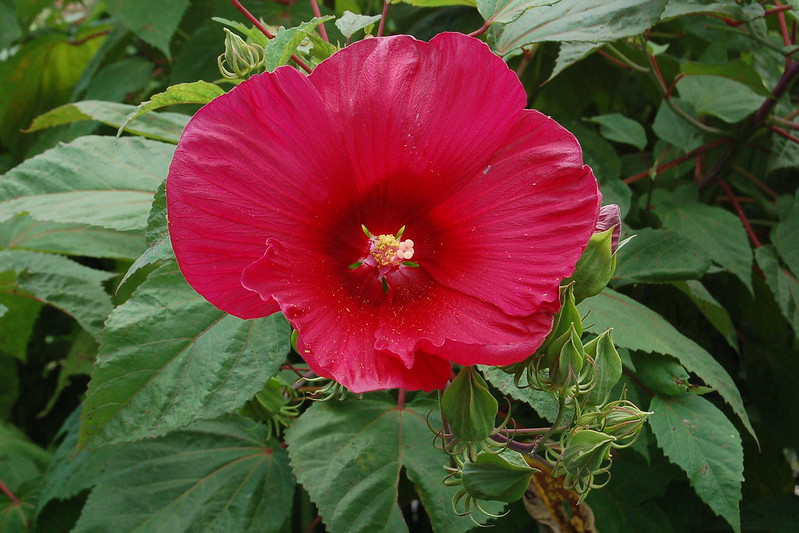
Hibiscus gives your landscape a tropical feel, but some hardy types will do well up to Zone 4. In the South, we can usually grow both hardy and tropical hibiscus, which offers so much beauty for little effort.
Hardy hibiscus is a slower-growing flowering bush, but they’re easy to care for. They’re one of the most popular flowering perennials for Florida, because they thrive in all corners of the state.
They like full sun and plenty of moisture and mulch. However, you won’t have to prune them as frequently as the tropical type. Best of all, hummingbirds love them.
Hardy Hibiscus Description
Hardy Hibiscus has heart-shaped leaves with a serrated edge and a deep green color. The leaves are usually quite large, ranging from 4 to 8 inches in length.
Hardy Hibiscus offers striking flowers, which are among the largest of any hardy perennial. The blossoms can reach up to 8 inches in diameter and come in a variety of colors, including shades of white, pink, red, and even bi-color combinations. These eye-catching flowers have prominent stamens and attract pollinators with their abundant nectar.
Hardy Hibiscus has a bushy growth habit, reaching a mature height of 4 to 7 feet and a spread of 3 to 6 feet, depending on the specific cultivar and growing conditions.
In temperate climates, the plant dies back to the ground in winter and regrows from the roots each spring.
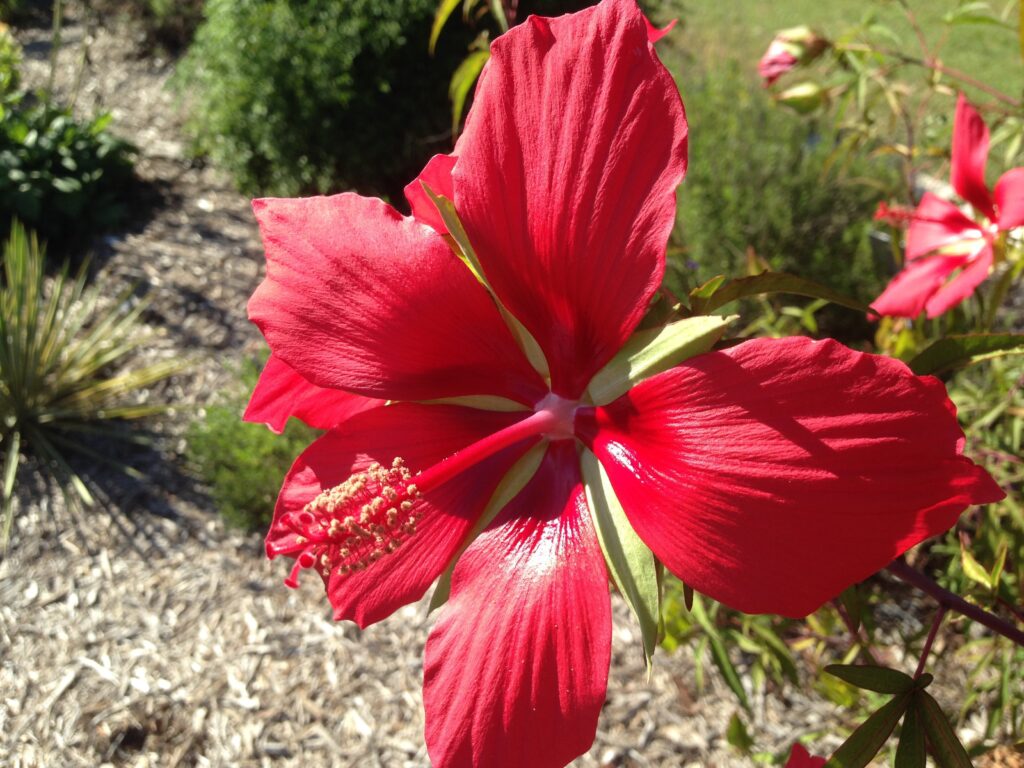
Optimal Growing Conditions for Hardy Hibiscus
Hardy Hibiscus is native to North America and is commonly found in wetlands, marshes, and along riverbanks. It thrives in areas with adequate moisture and is well-adapted to various soil conditions.
For optimal growth and abundant flowering, Hardy Hibiscus prefers full sun exposure. It tolerates a wide range of soil types, including clay and loam, as long as the soil is well-draining.
Although it is naturally found in wetland habitats, it can tolerate periods of drought once established.
Hardy Hibiscus is well-suited for Florida’s climate and is typically grown in hardiness zones 4 to 9. It is a tough and resilient plant that can withstand colder temperatures.
Florida Native Hardy Hibiscus
There are several varieties that are native to Florida that can be grown in Zones 8-11.
Scarlet Mallow (Hibiscus coccineus)
One Florida native species of hardy hibiscus is the Scarlet Mallow or Hibiscus coccineus. This native hibiscus is well-adapted to Florida’s wetland habitats and can be found in marshes, swamps, and along riverbanks. It is also commonly known as the Swamp Rose Mallow or Crimson-eyed Rose Mallow.
Hibiscus coccineus is known for its striking red flowers, which have a deep crimson eye in the center. The flowers are large and showy, attracting pollinators like bees and butterflies. The plant’s foliage is also appealing, with deeply lobed, maple-like leaves.
As a native species, Swamp Rose Mallow is an excellent choice for Florida landscaping, as it is well-suited to the state’s climate and soil conditions. It can thrive in both sunny and partially shaded areas, and it can tolerate periods of standing water, making it an ideal choice for rain gardens and other wetland landscaping projects.
Additionally, native flowering plants for Florida provide valuable habitat and food for local wildlife, further enhancing their ecological value in the garden.
Salt Marsh Mallow (Kosteletzkya virginica)
Salt Marsh Mallow is another native hibiscus species found in Florida. It is commonly referred to as Seashore Mallow or Virginia Saltmarsh Mallow. This hibiscus species is well-adapted to coastal habitats, including salt marshes, coastal dunes, and brackish wetlands, making it suitable for areas near the coast.
Salt Marsh Mallow features heart-shaped, green leaves with serrated edges. The leaves are soft and velvety to the touch. The flowers are typically pale pink to lavender in color and have five petals arranged in a funnel shape. The blooms are attractive to pollinators like bees and butterflies.
If you’re looking for pink flowering bushes in Florida, Salt Marsh Mallow is a sustainable choice. This herbaceous perennial plant has an upright growth habit. It can reach a height of 3 to 6 feet. As the name suggests, it thrives in salt marshes and other coastal areas where it can tolerate brackish water and saline soil conditions.
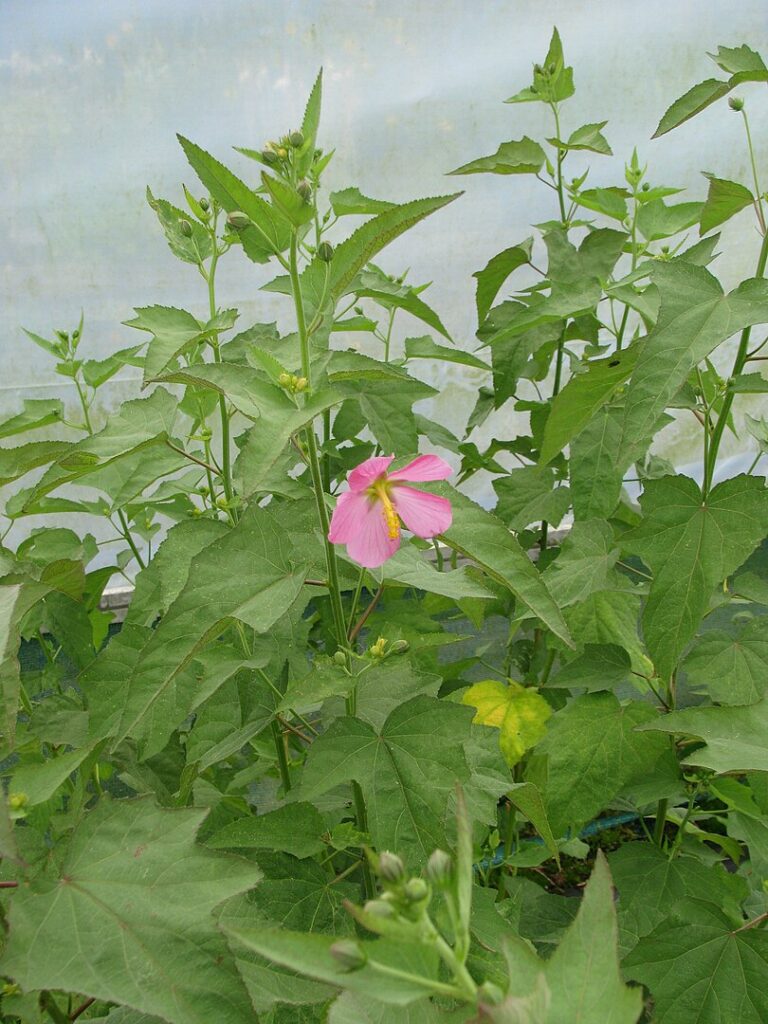
Salt Marsh Mallow typically grows in hardiness zones 8 to 11. Salt Marsh Mallow is ideal for landscapes near the coast, where it can thrive in saline conditions and contribute to coastal ecosystem restoration projects. The dense growth of Salt Marsh Mallow helps stabilize sandy soils, offering some erosion control benefits in vulnerable areas as well as contributing to the preservation of local biodiversity.
9. Bougainvillea (Bougainvillea spp.)
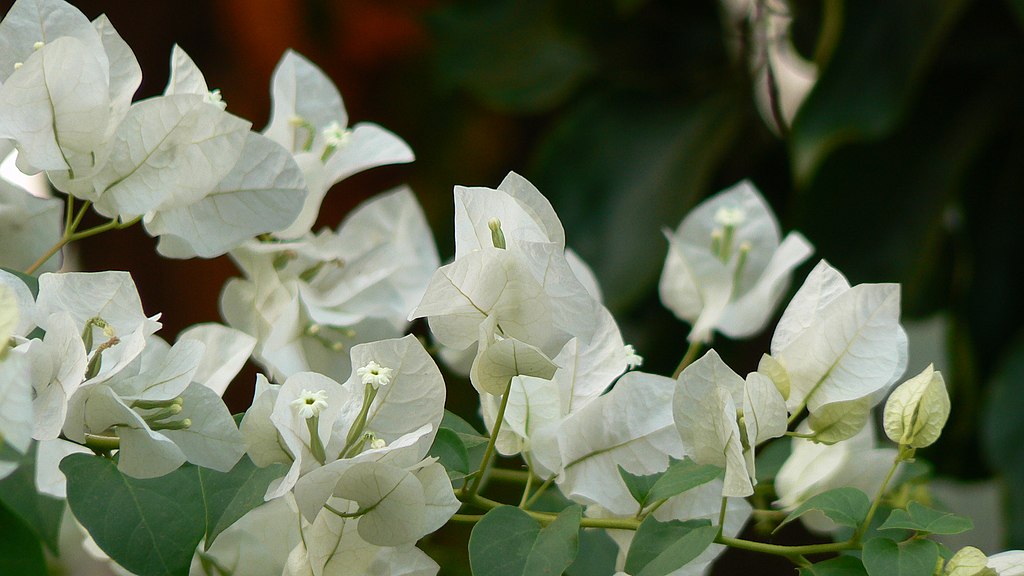
Bougainvillea captivates with its brilliant display of colors. This plant is commonly referred to as Paper Flower, Bougie, or simply Bougainvillea.
Bougainvillea features ovate to heart-shaped leaves with a smooth texture and a glossy appearance. The leaves are typically small and green, acting as a beautiful backdrop to the striking floral bracts that surround the inconspicuous flowers.
The true flowers are actually small and white, while the colorful bracts steal the show. What makes Bougainvillea truly exceptional are the vibrant papery bracts, which can appear in a stunning array of colors, including magenta, purple, red, pink, orange, and white.
Bougainvillea is a vigorous and fast-growing shrubby vine that can climb or trail, depending on its support structure. It can reach a mature height of 15 to 30 feet or more, and its spread can vary widely based on the cultivar and growing conditions. Some varieties can be pruned and trained as a shrub or small tree.
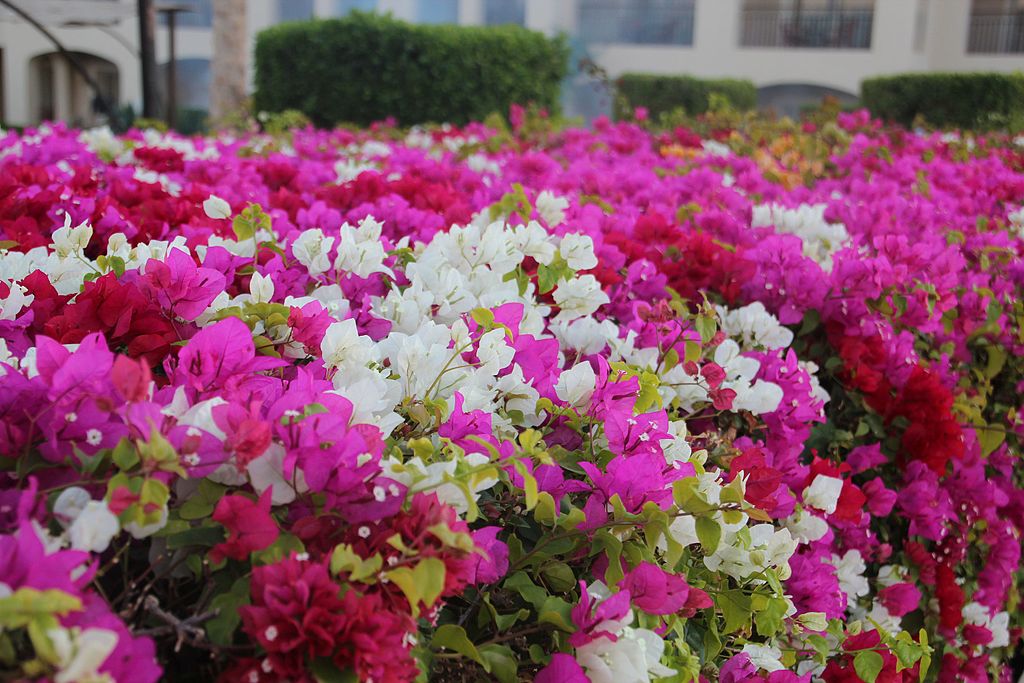
Optimal Growing Conditions for Bougainvillea
Bougainvillea originates from South America, specifically the regions of Brazil, Peru, and Argentina. It thrives in warm and tropical climates, which makes it well-suited for Florida’s subtropical environment.
Bougainvillea is a sun-loving plant that thrives in hot and humid conditions. The plant is relatively drought-tolerant once established, but regular watering is necessary to promote consistent flowering. Well-draining soil is essential to prevent waterlogged conditions.
Bougainvillea is well-suited for Florida’s climate and is typically grown in hardiness zones 9 to 11. It is a tropical plant that can withstand occasional light frost.
Bougainvillea is a profuse bloomer, with its colorful bracts persisting for an extended period from spring to fall. The striking bracts are rich in nectar, attracting bees, butterflies, and other pollinators to the garden.
Once established, Bougainvillea exhibits good drought tolerance, making it suitable for sustainable Florida-friendly landscape designs.
10. Plumbago (Plumbago auriculata)
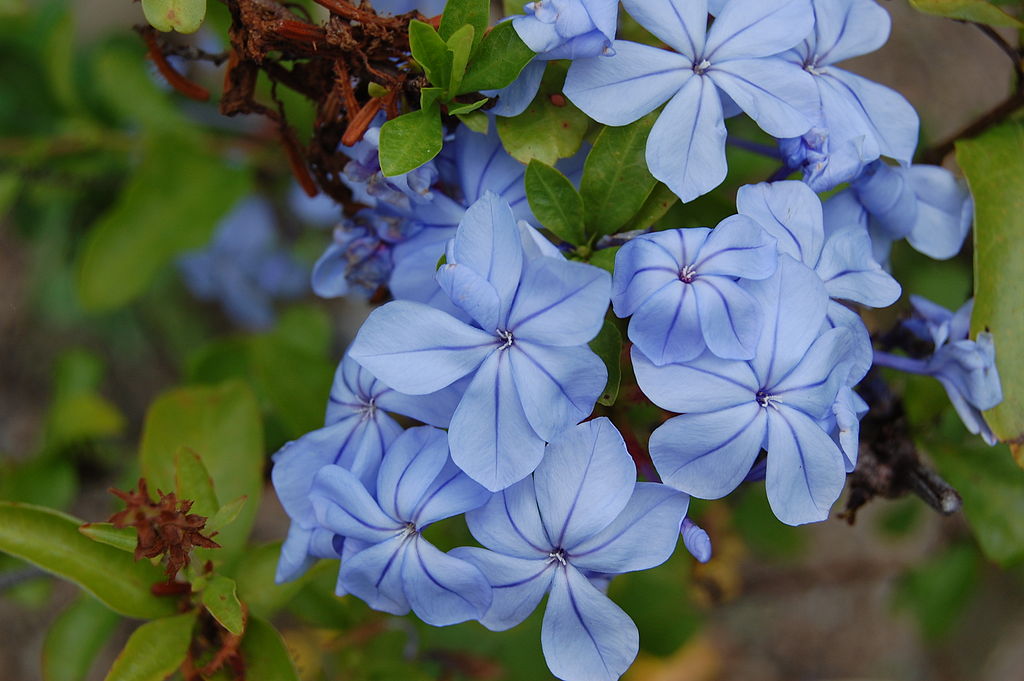
Although it sounds like a Victorian disease of the aged, Plumbago auriculata is a real doer in the garden if you take time to establish it properly.
This flowering bush explodes after the first year and is covered with blue flowers that resemble phlox. Bees seem to adore it, so it’s worth adding to any Southern pollinator garden.
You can plant it out at any time of year in Zone 9 and higher, and it will flower all year round. Note that it can be a pretty hungry plant, though it seems pretty tolerant of drought. Feed it well the first year, and it will grow at a disconcerting rate of speed. Forget to feed it, and you’ll get a yellow and sad-looking scrubby bush.
You can also find a white variety (alba) that to me seems less vigorous than the blue types. I’ve struggled to grow the white type from cuttings, while the blue takes pretty easily.

Optimal Growing Conditions for Cape Plumbago
Cape Plumbago originates from South Africa, specifically the Eastern Cape, KwaZulu-Natal, and Mpumalanga provinces. In its native habitat, it thrives in a variety of environments, from coastal dunes to mountain slopes, displaying its adaptability.
Plumbago auriculata prefers full sun exposure for the best flowering performance, but it can also tolerate partial shade. It thrives in well-draining soil that remains consistently moist but not waterlogged. Once established, it displays moderate drought tolerance.
Cape Plumbago is well-suited for Florida’s climate and thrives in hardiness zones 9 to 11. Its ability to endure mild cold spells while thriving in tropical to subtropical climates makes it an excellent landscaping choice for Florida.
Plumbago blooms from late spring through fall, providing an extended flowering period. The nectar-rich flowers are highly attractive to butterflies, which will visit the plant frequently, supporting the local population.
11. Princess Flower (Tibouchina urvilleana)
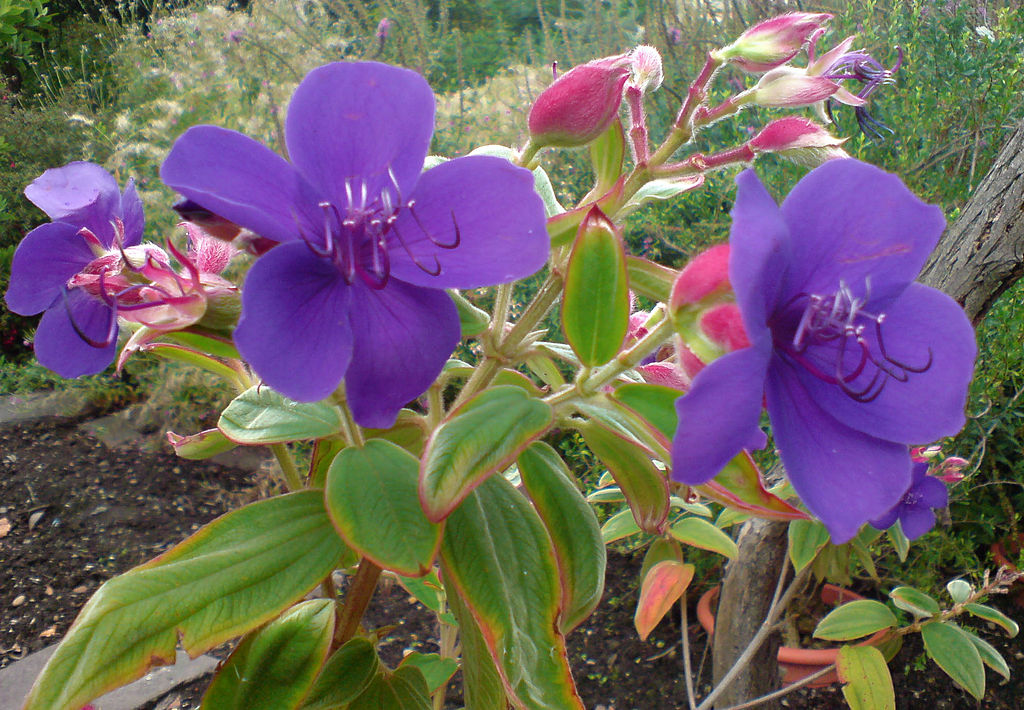
Technically known as Tibouchina urvillena, Princess Flower is a gorgeous tropical flowering bush that grows well in Zones 9 to 11. Although it may reach tree-like stature, most Southern gardeners keep it trimmed to bush size.
It will die back if exposed to frost, but in lower zones, you can cover it on nights it gets below 40 degrees Fahrenheit. And it is also suitable for containers for overwintering indoors in cooler climes.
It also doesn’t like to sit in the wind, so plant it in a protected corner.
Princess Flower can be thirsty, but it’s worth the effort. They’re also shade-tolerant, and I’ve found that mine does poorly in the scalding, Zone 10 summer sun, so I give it partial shade.
It’s a tropical plant, so it’s used to rich soil; you’ll need to feed it regularly during the growing season. I feed mine a high nitrogen fertilizer once all risk of frost is gone and then switch to a high-potassium formula when it warms enough to flower.
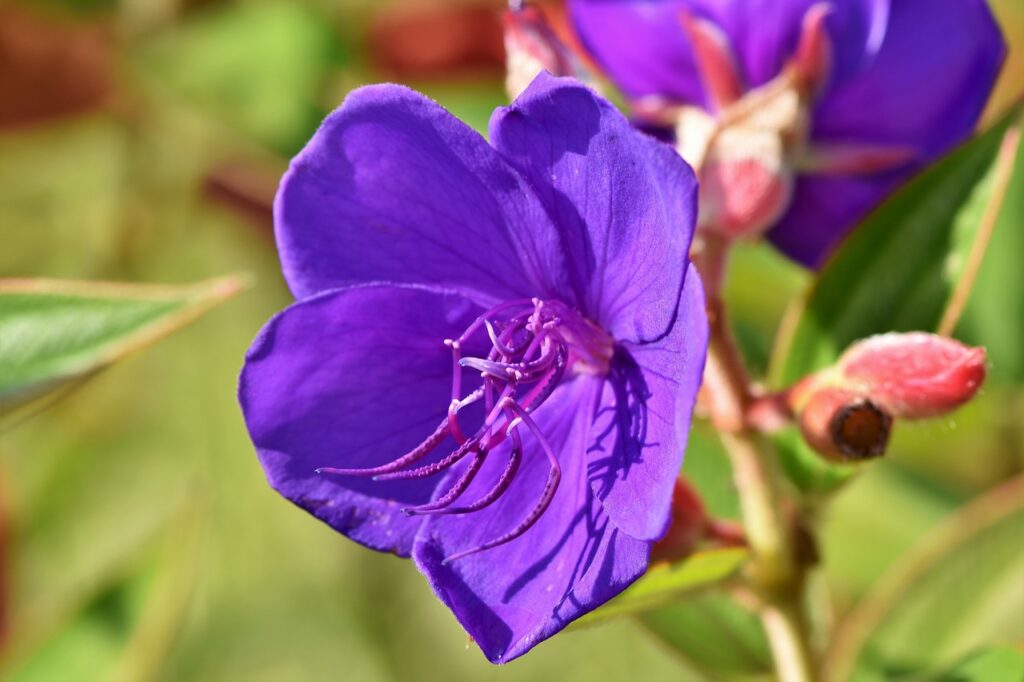
Optimal Growing Conditions for Tibouchina
Princess Flower originates from Brazil, where it is native to the Atlantic Rainforest region. It thrives in the warm, humid climates of its native habitat. It’s one of the most flowering plants for South Florida
For the best growth and flowering performance, Princess Flower prefers full to partial sun exposure. It may produce fewer blooms if there is too much shade.
The plant thrives in well-draining soil that retains moisture but does not become waterlogged. Adequate watering and mulching help maintain soil moisture, especially during dry periods.
Tibouchina urvilleana is well-adapted to Florida’s climate and thrives in hardiness zones 9 to 11. It can tolerate occasional light frost while flourishing in tropical to subtropical climates makes it an excellent choice for Florida landscaping.
Princess Flower blooms from late spring through fall, with peak flowering usually occurring in late summer. The striking flowers attract various pollinators, including butterflies and hummingbirds, contributing to the garden’s biodiversity.
12. Tropical Hibiscus

Popular in coastal gardens along the Gulf of Mexico, tropical hibiscus gives a very Caribbean feel to your landscaping. While most cultivars are hardy in Zones 10 and 11, you can easily nurse them through winters up to Zone 8.
Like hardy varieties, they love full sun and plenty of water. Mulch them heavily to keep them thriving.
Tropical Hibiscus has glossy, dark green leaves with a leathery texture, and they serve as an attractive backdrop for the striking flowers. In some cultivars, the foliage may have variations in color, such as burgundy-tinged edges or variegated patterns, adding to its visual appeal.
Tropical Hibiscus boasts large, showy, trumpet-shaped flowers, which come in a array of colors. These blossoms may appear in shades of red, pink, orange, yellow, and even white. Some cultivars feature captivating color combinations and intricate patterns on the petals, making each flower a unique work of art.
Hibiscus rosa-sinensis has a relatively compact growth habit, making it suitable for both container planting and landscaping. It can reach a mature height of 4 to 8 feet and a spread of 3 to 6 feet, depending on the variety and growing conditions.
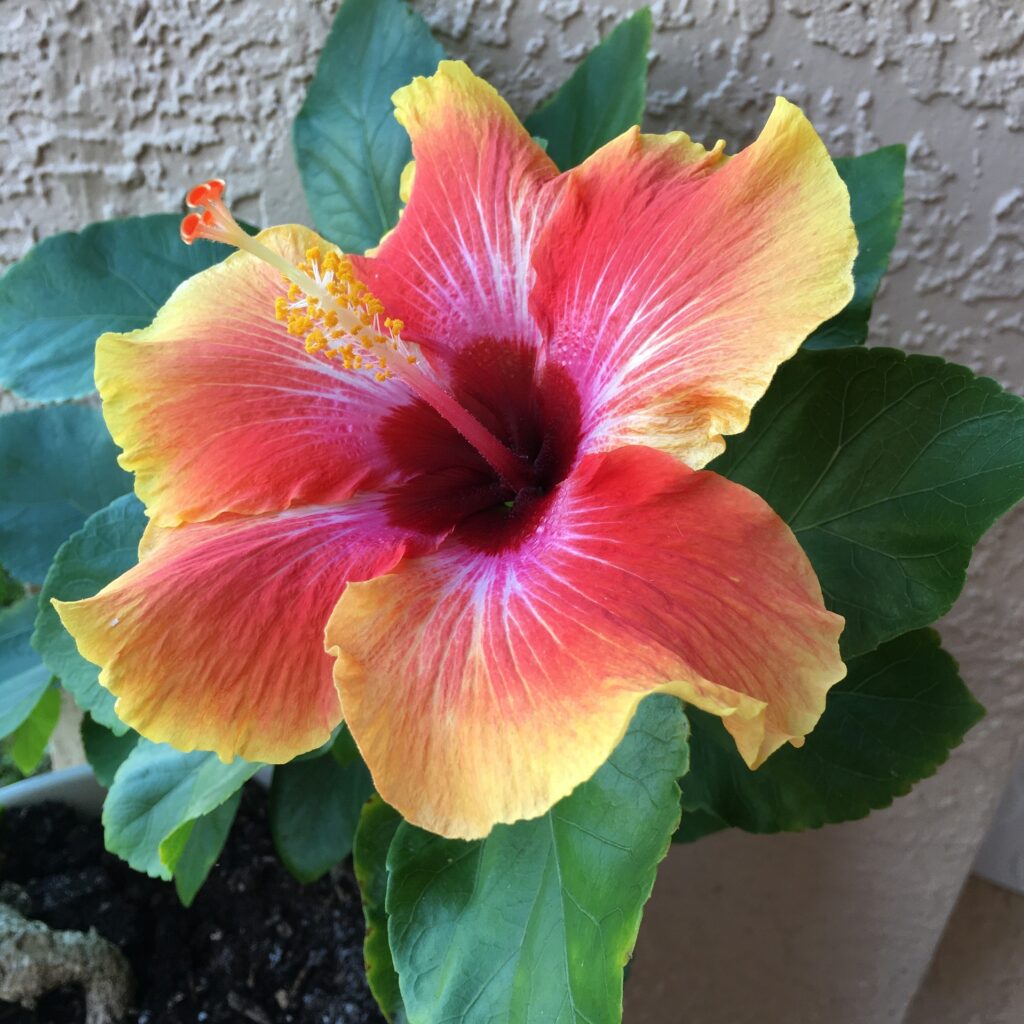
Optimal Growing Conditions for Tropical Hibiscus
Tropical Hibiscus originates from East Asia, particularly China and has spread to many tropical and subtropical regions around the world, including Florida.
Tropical Hibiscus requires full sun exposure. It flourishes in well-draining soil with consistent moisture levels.
Tropical Hibiscus is suited for hardiness zones 9 to 11. Its preference for warm temperatures and ability to withstand mild frost make it a popular choice for Florida landscapes.
Tropical Hibiscus produces an abundance of showy flowers throughout the warm months, with peak blooming occurring in spring and summer. The nectar-rich blossoms attract various pollinators, such as bees and butterflies.
Thriving in warm and humid climates, Tropical Hibiscus is perfectly adapted to Florida’s conditions, making it a low-maintenance and sustainable flowering bush to add to the landscape.
How to Pick the Best Flowering Bushes for Florida
It should be easy to find flowering plants for Florida, including flowering shrubs and vines. Our subtropical climate is a garden designer’s dream because we can grow such a wide variety of ornamental landscape plants.
Check your local home improvement store or nursery to find starters or seeds. You can also purchase them in 1, 3, and 5-gallon size containers if you want instant gratification. One advantage to this is that you know what they’ll look like when they bloom and can take cuttings immediately to propagate.
You can also purchase online from nurseries. We frequently carry some of these varieties in our shop and in our Etsy store.
Patience pays off when it comes to flowering shrubs. Once they’ve gotten established, the best flowering bushes for Florida will bloom year after year, attracting bees and butterflies into your garden and giving your landscape real curb appeal. your perennial garden plants will bloom year after year.
Image CC0 via Pxhere
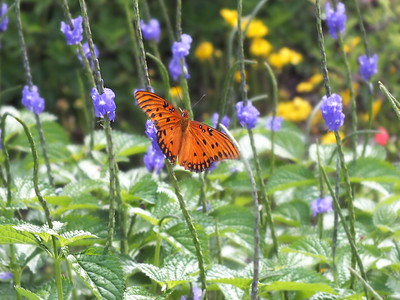
1 thought on “The 12 Best Flowering Bushes for Florida”
Comments are closed.